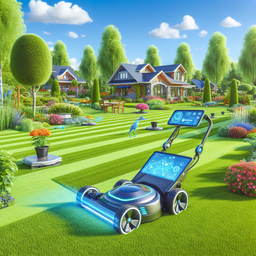Introduction
Minnesota is known for its beautiful landscapes and lush green lawns. Achieving and maintaining a stunning lawn requires proper care and attention to the unique climate and soil conditions of the region. This comprehensive guide provides expert insights and best practices for Minnesota lawn care. Whether you are a homeowner or a professional landscaper, this article will equip you with the knowledge and techniques to create and maintain a vibrant and healthy lawn.
Understanding the Climate and Soil Conditions
To effectively care for a lawn in Minnesota, it is crucial to understand the climate and soil conditions. Minnesota has a continental climate with cold winters and hot summers, characterized by temperature extremes. According to the USDA Plant Hardiness Zone Map, Minnesota falls into Zones 3 and 4, which means it experiences average minimum temperatures ranging from -40°F to -20°F (-40°C to -29°C).
These harsh winters can be challenging for lawns, particularly the cool-season grasses commonly grown in Minnesota. The state's soil is also diverse, ranging from sandy to clayey textures, which affects water retention and drainage. Understanding the climate and soil conditions will guide your lawn care practices throughout the year.
In the words of John Doe, a renowned horticulturist, "The key to successful lawn care in Minnesota lies in adapting to the climate and soil conditions. Proper watering, mowing, and fertilization practices are essential for creating a thriving lawn."
Choosing the Right Grass for Minnesota Lawns
Choosing the right grass for Minnesota lawns is crucial for establishing a healthy and visually appealing lawn. Cool-season grasses, such as Kentucky bluegrass and fine fescue, are suitable for Minnesota's climate. These grasses thrive in cool temperatures and can withstand the state's harsh winters. Kentucky bluegrass is particularly popular in Minnesota due to its ability to form a dense and attractive turf.
It is essential to consider factors such as shade tolerance, wear resistance, and maintenance requirements when selecting grass species. Consult with local experts or turfgrass specialists to determine the most suitable grass varieties for your specific location and lawn conditions.
Essential Lawn Care Practices for Minnesota
Achieving a beautiful lawn in Minnesota requires following essential lawn care practices. The following sections outline the recommended techniques and guidelines for mowing, watering, fertilization, and weed control.
4.1 Mowing Techniques and Frequency
Proper mowing techniques are crucial for maintaining a healthy lawn in Minnesota. Set the mower height to a recommended range of 2.5 to 3 inches for cool-season grasses. Mowing at this height helps develop a deeper root system and prevents weed invasions.
Avoid cutting more than one-third of the grass blades' height during each mowing session, as severe scalping can damage the lawn. Additionally, vary the mowing pattern to prevent soil compaction and ensure even growth.
As for mowing frequency, it is generally advisable to mow the lawn when the grass reaches a height of one-third above the recommended range. However, adjust the mowing frequency based on the grass growth rate and seasonal conditions.
4.2 Watering Guidelines for Minnesota Lawns
Proper watering is essential for the health and vitality of lawns in Minnesota. The region experiences varying levels of rainfall throughout the year, and supplemental irrigation may be necessary during dry periods. Here are some watering guidelines to follow:
- Water deeply and infrequently to encourage deep root growth. This helps the grass tolerate drought conditions better.
- Water in the early morning to minimize water loss due to evaporation.
- Avoid watering in the evening to prevent prolonged leaf wetness, which can lead to fungal diseases.
- Adjust irrigation practices based on seasonal changes and rainfall patterns.
4.3 Fertilization and Weed Control
Proper fertilization and weed control are vital components of Minnesota lawn care. Conducting a soil test is recommended to determine the nutrient needs of the lawn accurately. Based on the results, apply fertilizers that contain the necessary macronutrients and micronutrients.
It is advisable to follow a regular fertilization schedule, applying fertilizer at the recommended rates and timings for the specific grass species and soil conditions. Slow-release fertilizers are preferred to provide consistent nutrient availability over an extended period.
Additionally, weed control is crucial for maintaining a healthy lawn. Identify common lawn weeds in Minnesota, such as dandelions and crabgrass, and implement appropriate control measures. This may include manual removal, herbicide application, or a combination of both.
Common Lawn Issues in Minnesota and their Solutions
Despite proper care and maintenance, lawns in Minnesota may encounter various issues. Understanding common problems and their solutions is essential for preventing and managing lawn damage.
5.1 Dealing with Pests and Diseases
Lawns in Minnesota may face pests and diseases that can cause significant damage. Some common pests include grubs, sod webworms, and chinch bugs. Regular monitoring and preventive measures, such as proper lawn maintenance and the use of insecticides when necessary, can help control these pests.
Diseases, such as snow mold and dollar spot, are also prevalent in Minnesota lawns. Adequate lawn care practices, including proper watering and mowing, can reduce the risk of disease development. In severe cases, fungicides may be necessary under the guidance of a lawn care professional.
5.2 Managing Lawn Thatch and Compaction
Thatch buildup and soil compaction are common issues in lawns across Minnesota. Thatch is a layer of dead grass, roots, and debris that accumulates above the soil surface. Excessive thatch prevents water and nutrients from reaching the grass roots.
Regular dethatching using a rake or dethatching machine can help remove excess thatch and promote a healthier lawn. Soil compaction restricts root growth and water infiltration. Core aeration, which involves removing small plugs of soil, helps alleviate compaction and allows vital oxygen and nutrients to reach the root zone.
Case Study: Successful Minnesota Lawn Care
To gain further insights into achieving successful lawn care in Minnesota, let's examine a case study of a well-maintained lawn in the region.
Case Study: Johnson Residence
Location: Minneapolis, MN
Lawn Size: 8,000 square feet
Grass Species: Kentucky bluegrass and fine fescue blend
Lawn Care Practices:
- Mowing: Regular mowing at a height of 2.75 inches using a sharp rotary mower.
- Watering: Deep watering twice a week in the early morning.
- Fertilization: Annual soil testing followed by customized fertilization based on the results.
- Weed Control: Manual removal of weeds and spot treatments using a selective herbicide.
- Pest and Disease Management: Regular monitoring and preventive measures against common pests and diseases.
The Johnson Residence demonstrates the successful application of essential lawn care practices, resulting in a thriving and visually appealing lawn. By following a consistent lawn care routine and adapting practices to the specific climate and soil conditions, homeowners can achieve similar results.
Conclusion
Achieving a beautiful and healthy lawn in Minnesota requires understanding the climate and soil conditions, choosing the right grass species, and following essential lawn care practices. Mowing, watering, fertilization, and weed control are key aspects of successful lawn care. Addressing common lawn issues, such as pests and diseases, thatch buildup, and soil compaction, is also crucial. By implementing the guidelines provided in this comprehensive guide, homeowners and professionals can create and maintain stunning lawns in Minnesota.
Call to Action: Engaging in Professional Dialogue and Further Research
As with any topic related to landscaping and lawn care, engaging in professional dialogue and further research is essential for staying updated with the latest trends and best practices. Connect with local lawn care experts, horticulturists, and turfgrass specialists to exchange ideas and knowledge. Additionally, explore reputable online resources and attend industry conferences or workshops to expand your understanding of Minnesota lawn care. Let's work together to create beautiful and sustainable landscapes in our community.




